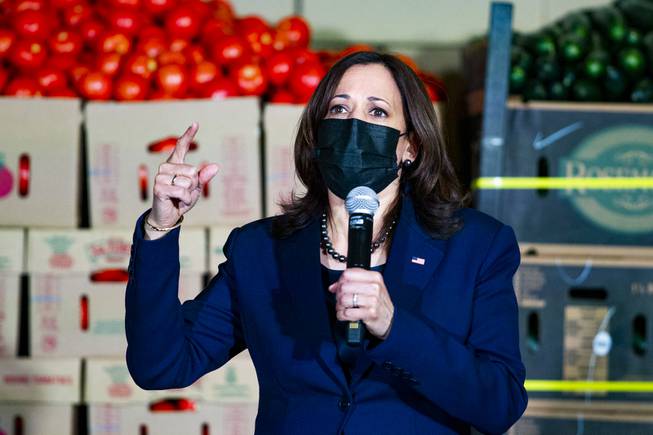
Vice President Kamala Harris speaks during a cross-country stimulus package tour stop at the Culinary Academy of Las Vegas, Monday, March 15, 2021.
Tuesday, July 13, 2021 | 2 a.m.
WASHINGTON — If all goes as planned, the Treasury Department will begin making a series of monthly payments in coming days to families with children, setting a milestone in social policy and intensifying a debate over whether to make the subsidies a permanent part of the American safety net.
With all but the most affluent families eligible to receive up to $300 a month per child, the United States will join many other rich countries that provide a guaranteed income for children, a goal that has long animated progressives. Experts estimate the payments will cut child poverty by nearly half, an achievement with no precedent.
But the program, created as part of the stimulus bill that Democrats passed over unified Republican opposition in March, expires in a year, and the rollout could help or hinder President Joe Biden’s pledge to extend it.
Immediate challenges loom. The government is uncertain how to get the payments to millions of hard-to-reach families, a problem that could undermine its poverty-fighting goals. Opponents of the effort will be watching for delivery glitches, examples of waste or signs that the money erodes the desire of some parents to work.
While the government has increased many aid programs during the coronavirus pandemic, supporters say the payments from an expanded Child Tax Credit, at a one-year cost of about $105 billion, are unique in their potential to stabilize both poor and middle-class families.
“It’s the most transformative policy coming out of Washington since the days of FDR,” said Sen. Cory Booker, D-N.J. “America is dramatically behind its industrial peers in investing in our children. We have some of the highest child poverty rates, but even families that are not poor are struggling, as the cost of raising children goes higher and higher.”
Among America’s 74 million children, nearly 9 in 10 will qualify for the new monthly payments — up to $250 a child, or $300 for those under 6 — which are scheduled to start Thursday. Those payments, most of which will be sent to bank accounts through direct deposit, will total half of the year’s subsidy, with the rest to come as a tax refund next year.
Biden has proposed a four-year extension in a broader package he hopes to pass this fall, and congressional Democrats have vowed to make the program permanent. Like much of Biden’s agenda, the program’s fate may depend on whether Democrats can unite around the bigger package and advance it through the evenly divided Senate.
The unconditional payments — what critics call “welfare” — break with a quarter century of policy. Since President Bill Clinton signed a 1996 bill to “end welfare,” aid has gone almost entirely to parents who work. Sen. Marco Rubio, R-Fla., recently wrote that the new payments, with “no work required,” would resurrect a “failed welfare system,” and provide “free money” for criminals and addicts.
But compared to past aid debates, opposition has so far been muted. A few conservatives support children’s subsidies, which might boost falling birthrates and allow more parents to raise children full time. Sen. Mitt Romney, R-Utah, has proposed a larger child benefit, though he would finance it by cutting other programs.
With Congress requiring payments to start just four months after the bill’s passage, the administration has scrambled to spread the word and assemble payment rosters.
Families that filed recent tax returns or received stimulus checks should get paid automatically. (Single parents with incomes up to $112,500 and married couples with incomes up to $150,000 are eligible for the full benefit.) But analysts say 4 million to 8 million low-income children may be missing from the lists, and drives are underway to get their parents to register online.
“Wherever you run into people — perfect strangers — just go on up and introduce yourself and tell them about the Child Tax Credit,” Vice President Kamala Harris said last month on what the White House called “Child Tax Credit Awareness Day.”
Among the needy, the program is eliciting a mixture of excitement, confusion and disbelief. Fresh EBT, a phone app for people who receive food stamps, found that 90% of its users knew of the benefit, but few understand how it works.
“Half say, ‘I’m really, really ready to get it,’” said Stacy Taylor, the head of policy and partnerships at Propel, the app’s creator. “The others are a mix of ‘I’m worried I haven’t taken the right steps’ or ‘I’m not sure I really believe it’s true.’”
Few places evoke need more than Lake Providence, Louisiana, a hamlet along the Mississippi River where roughly three-quarters of the children are poor, including those of Tammy Wilson, 50, a jobless nursing aide.
The $750 a month she should receive for three children will more than double a monthly income that consists only of food stamps and leaves her relying on a boyfriend. “I think it’s a great idea,” she said. “There’s no jobs here.”
While the money will help with rent, Wilson said, the biggest benefit would be the ability to send her children to activities like camps and school trips.
“Kids get to bullying, talking down on them — saying ‘Oh your mama don’t have money,’” she said. “They feel like it’s their fault.”
But in West Monroe, a 90-minute drive away, Levi Sullivan, another low-income parent, described the program as wasteful and counterproductive. Sullivan, a pipeline worker, has been jobless for more than a year but argued the payments would increase the national debt and reward indolence.
“I’m a Christian believer — I rely on God more than I rely on the government,” he said.
This article originally appeared in The New York Times.
